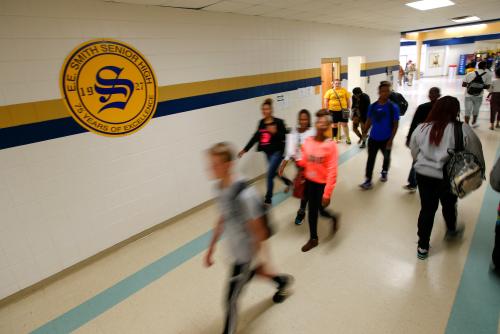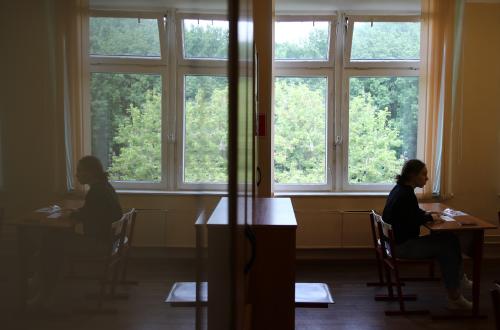This blog is part of the “School Discipline in America” series. In this series, experts from Brookings and RAND explore how U.S. public schools approach student discipline and educators’ perspectives on disciplinary approaches and challenges, providing key insights into contemporary debates over student discipline practices and policies.
As U.S. criminal justice policies came to reflect the “broken windows” theory of policing in the 1990s, so too did school discipline policies. The “broken windows” philosophy—which encouraged harsh punishments for even minor infractions to dissuade individuals from committing more serious offenses—characterized schools’ use of zero-tolerance policies. These policies required educators to suspend or expel students for certain types of infractions, often including low-level, nonviolent offenses.
In this context, schools’ use of suspensions and expulsions—practices commonly referred to as exclusionary discipline—grew, particularly in secondary schools and schools serving higher shares of Black and Latino youth. Notably, the sharp increase in suspensions observed in the 1990s and early 2000s was driven by increases among students of color. As a result, racial inequalities in student discipline widened significantly.
Over the last decade, a flurry of policy activity has aimed to curb schools’ use of exclusionary discipline practices in favor of less punitive approaches that keep kids in school. Some states (e.g., California, Arkansas, and Oregon) and school districts (e.g., Los Angeles Unified, School District of Philadelphia, and Chicago Public Schools) have revised policies to limit the use of suspensions for certain low-level, nonviolent offenses (especially in elementary grades). And growing numbers of schools have adopted alternative discipline practices like restorative justice programs and behavioral interventions (e.g., Positive Behavioral Interventions and Supports).
These are positive developments. Research has shown that some of these alternative approaches can reduce the prevalence of exclusionary discipline. (Although, research is mixed as to whether these approaches can reduce racial inequalities.) Moreover, other work suggests that some alternatives to exclusionary discipline can have positive effects on student and teacher perceptions of school safety.
How widespread are recent efforts to reform school discipline? Because public education in the U.S. is highly decentralized, our understanding of the landscape of schools’ discipline policies and practices is limited. Do zero-tolerance policies remain prevalent today? And how common have alternative approaches to student discipline become?
To find out, we and colleagues at the RAND Corporation surveyed 1,080 public school principals across the U.S. in November 2021 using RAND’s nationally representative American School Leader Panel. Among other topics, we asked principals whether their school had zero-tolerance discipline policies and whether their school’s policies allow them to suspend students for low-level offenses like willful defiance. We also asked principals about their use of alternative approaches to exclusionary discipline. Because we know that schools’ disciplinary approaches have historically varied by grade level and schools’ racial/ethnic makeup, we consider how principals’ responses to our survey differed by their school context.[1]
Zero-tolerance policies remain prevalent, but only for the most serious offenses
A majority (62%) of U.S. public schools had zero-tolerance policies—or mandatory penalties for students who break certain rules—in place during the 2021–2022 school year (see Figure 1). Overall, zero-tolerance policies remain more common in secondary (middle/high) schools than elementary schools. At the elementary level, schools with different racial/ethnic populations were roughly equally likely to have zero-tolerance policies. But at the secondary level, stark differences emerged. Relative to secondary schools with mostly white populations, schools serving mostly Black students were much more likely to have zero-tolerance policies (82% compared to 68%). This concerning pattern is consistent with prior research.
Among schools with zero-tolerance discipline policies in 2021-2022, most only applied to more serious offenses like bringing a weapon to school. This is unsurprising given that zero-tolerance policies were originally intended to quell drug and gun possession in schools. Almost all schools (98%) with zero-tolerance policies said the policies covered infractions involving guns, and 80% said their policies covered knives. Meanwhile, 85% said their zero-tolerance policies extended to possession of illegal drugs. Importantly, however, among schools with zero-tolerance policies, a small share (6%) continues to include low-level, nonviolent offenses like willful defiance.
Suspensions for willful defiance and disobedience remain common
Willful defiance and disobedience are categories of low-level, nonviolent offenses that can include misbehaviors like talking back to a teacher or not listening to a teacher’s instructions. Despite recent policy movement in some areas of the country, most schools (76%) continued to allow educators to suspend students for these types of offenses in 2021–2022 (see Figure 2). Overall, this practice was more common in secondary schools than in elementary schools. This pattern is consistent both with our understanding of the policy activity around student discipline (which has been focused more on limiting suspensions for students in elementary grades), and with prior work showing heightened levels of discipline in middle and high school grades.
There were also interesting differences by schools’ racial/ethnic makeup. Schools with student populations that were neither majority white nor majority Black in 2021–2022 were less likely to allow suspensions for willful defiance and disobedience than schools that were either majority white or majority Black.
Large shares of schools have adopted alternative approaches to exclusionary discipline
Finally, we gauged the prevalence of four popular alternative approaches to exclusionary discipline in U.S. public schools. Positive Behavioral Interventions and Supports, or PBIS, is a program that aims to define schoolwide behavioral expectations and norms. It rewards students who meet those expectations while providing supports to students who do not meet them. Restorative justice programs and practices aim to cultivate a more inclusive and equitable school climate by supporting students and educators in developing conflict resolution skills. Social emotional learning (SEL) programs and multi-tiered systems of support (MTSS) are programs broadly related to improving school climate and preventing student behavioral challenges.
Interestingly, principals reported that all four alternative approaches were widely used in U.S. public schools in 2021–2022 (Figure 3). However, the prevalence varied by school context. All programs except restorative justice practices were more common in elementary schools than in secondary schools. At the secondary level, the prevalence of these programs relates to the racial/ethnic composition of the school. For example, SEL programs were far less common in secondary schools with majority Black student populations in 2021–2022.
More work is needed to document schools’ disciplinary policies and practices
Results from our national survey of school principals suggest that the “broken windows” era of school discipline may be waning. Where zero-tolerance policies remain, they tend to cover only the most serious offenses like bringing a gun or other weapon to school. Still, though, large shares of schools continue to allow educators to suspend students for low-level, nonviolent behaviors. Importantly, it remains unclear from our work whether suspensions for these types of offenses remain prevalent. More work is needed to understand how schools’ disciplinary practices have shifted during this period.
What schools replace punitive discipline approaches with matters, especially since we know that managing student behavior and discipline are aspects of teaching that most educators struggle with. Our data suggest that most public schools are investing in alternative approaches to exclusionary discipline.
Given what we know about the harmful outcomes associated with suspensions and the racially disparate impact of exclusionary discipline policies and practices, it is imperative that researchers continue to track how schools are approaching student discipline and how various approaches impact student outcomes and equity.
For more details on the survey and the complete set of survey results, click here.
Rachel M. Perera is an alumna of the Pardee RAND Graduate School and a past employee of the RAND corporation during which time she completed the majority of her contribution to this project. Perera remains an adjunct policy researcher with the RAND corporation and received financial support from RAND to complete this project. The findings, interpretations, and conclusions in this report are solely those of the authors and do not represent positions or policies of the RAND Corporation, Brookings Institution, its officers, employees or other donors. Brookings is committed to quality, independence, and impact in all of its work.
Footnotes:
[1] In addition to the questions about school discipline policies and practices we discuss in this post, our survey included potentially sensitive questions about respondents’ racial attitudes. To ensure that individuals could not be identified in our survey data, we obtained only limited information about schools’ student demographics and contexts. Therefore, we report our results by school racial/ethnic composition using a categorical variable with three groups: “Mostly Black,” “Mostly White”, and “Neither” (where the “Neither” category represents schools that are neither majority Black nor majority white). Because “Mostly Black” schools represent a small share of U.S. public schools, we note that our sample sizes for this subgroup—at both the elementary and secondary levels—are smaller than for the other subgroups. Thus, we encourage readers to interpret these results with some caution. While we do not know the specific racial/ethnic breakdown among students in the schools categorized as “Neither,” we estimate this group is comprised of roughly half schools that are majority Latino and half schools in which none of these racial/ethnic groups comprise a majority based on patterns we observe among the national population of U.S. public schools. (Back to top)
-
Acknowledgements and disclosures
We gratefully acknowledge financial support for this project from RAND’s sponsored research program; funding for this research was provided by gifts from RAND supporters and income from RAND operations.











